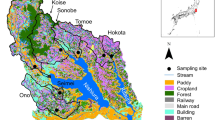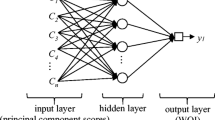Abstract
A simple method based on the mathematical treatment of spectral absorbance profiles in conjunction with artificial neural networks (ANNs) is demonstrated for rapidly estimating chemical oxygen demand (COD) values of wastewater samples. In order to improve spectroscopic analysis and ANN training time as well as to reduce the storage space of the trained ANN algorithm, it is necessary to decrease the ANN input vector size by extracting unique characteristics from the raw input pattern. Key features from the spectral absorbance pattern were therefore selected to obtain the spectral absorbance profile, reducing the ANN input vector from 160 to 10 selected inputs. The results indicate that the COD values obtained from the selected absorbance profiles agreed well with those obtained from the entire absorbance pattern. The spectral absorbance profile technique was also compared to COD values estimated by a multiple linear regression (MLR) model to validate whether ANNs were better and more robust models for rapid COD analysis. It was found that the ANN model predicted COD values closer to standard COD values than the MLR model.





Similar content being viewed by others
Abbreviations
- ANN:
-
Artificial neural network
- COD:
-
Chemical oxygen demand
- BOD:
-
Biochemical oxygen demand
- MLR:
-
Multiple linear regression
References
Charef A, Ghauch A, Baussand P, Martin-Bouyer M (2000) Water quality monitoring using smart sensing system. Measurement 28:219–224
Fogelman S (2002) Towards the development of a rapid, real-time, indirect method for determining oxygen demand in waters and wastewaters. School of Environmental and Applied Sciences, Griffith University, Gold Coast
Brookman S (1997) Estimation of biochemical oxygen demand in slurry and effluents using ultra violet spectrometry. Water Res 32(2):372–374
Khorassani H, Trebuchon P, Bitar H, Thomas O (1999) A simple UV spectrophotometric procedure for the survey of industrial sewage system. Water Sci Tech 39(10–11):77–82
Markva M (1983) Evaluation of correlation between absorbance at 254 nm and COD in river water. Water Res 17:231–235
American Public Health Association, American Water Work Association, Water Environment Federation (1995) Standard methods for the examination of water and wastewater. APHA-AWWA-WPCF, Washington, DC
Blumenstein M, Liu XY, Verma B (2004) A modified direction feature for cursive character recognition. International Joint Conference on Neural Networks (IJCNN 2004), Budapest, pp 2983–2987
Antognetti P, Milutinovic V (1991) Neural networks: concepts, applications and implementations. Prentice-Hall, Englewood Cliffs, NJ
Rumelhart D, Hinton G, Williams R (1986) Learning internal representations by error propagation, in parallel distributed processing: explorations in the microstructures of cognition. MIT Press, Cambridge
Sokal R, Rohlf F (1969) Biometry: the principles and practice of statistics in biological research. Freeman, San Francisco, CA
Silverstein R, Bassler G, Morrill T (1981) Spectrometric identification of organic compounds. Wiley, Mississauga, ON
Acknowledgements
We would like to acknowledge the Australian CRC for Water Quality and Treatment for funding.
Author information
Authors and Affiliations
Corresponding author
Rights and permissions
About this article
Cite this article
Fogelman, S., Blumenstein, M. & Zhao, H. Estimation of chemical oxygen demand by ultraviolet spectroscopic profiling and artificial neural networks. Neural Comput & Applic 15, 197–203 (2006). https://doi.org/10.1007/s00521-005-0015-9
Received:
Accepted:
Published:
Issue Date:
DOI: https://doi.org/10.1007/s00521-005-0015-9




